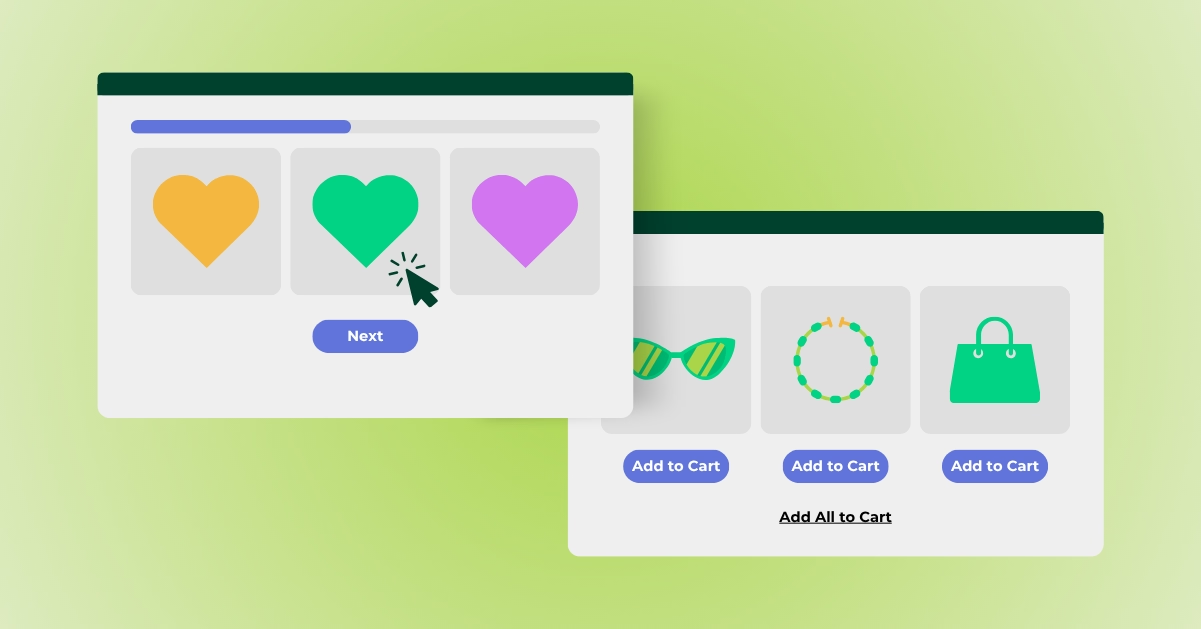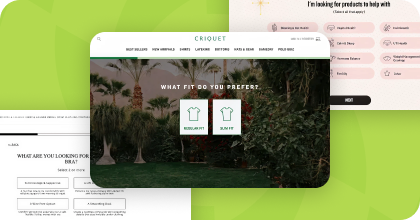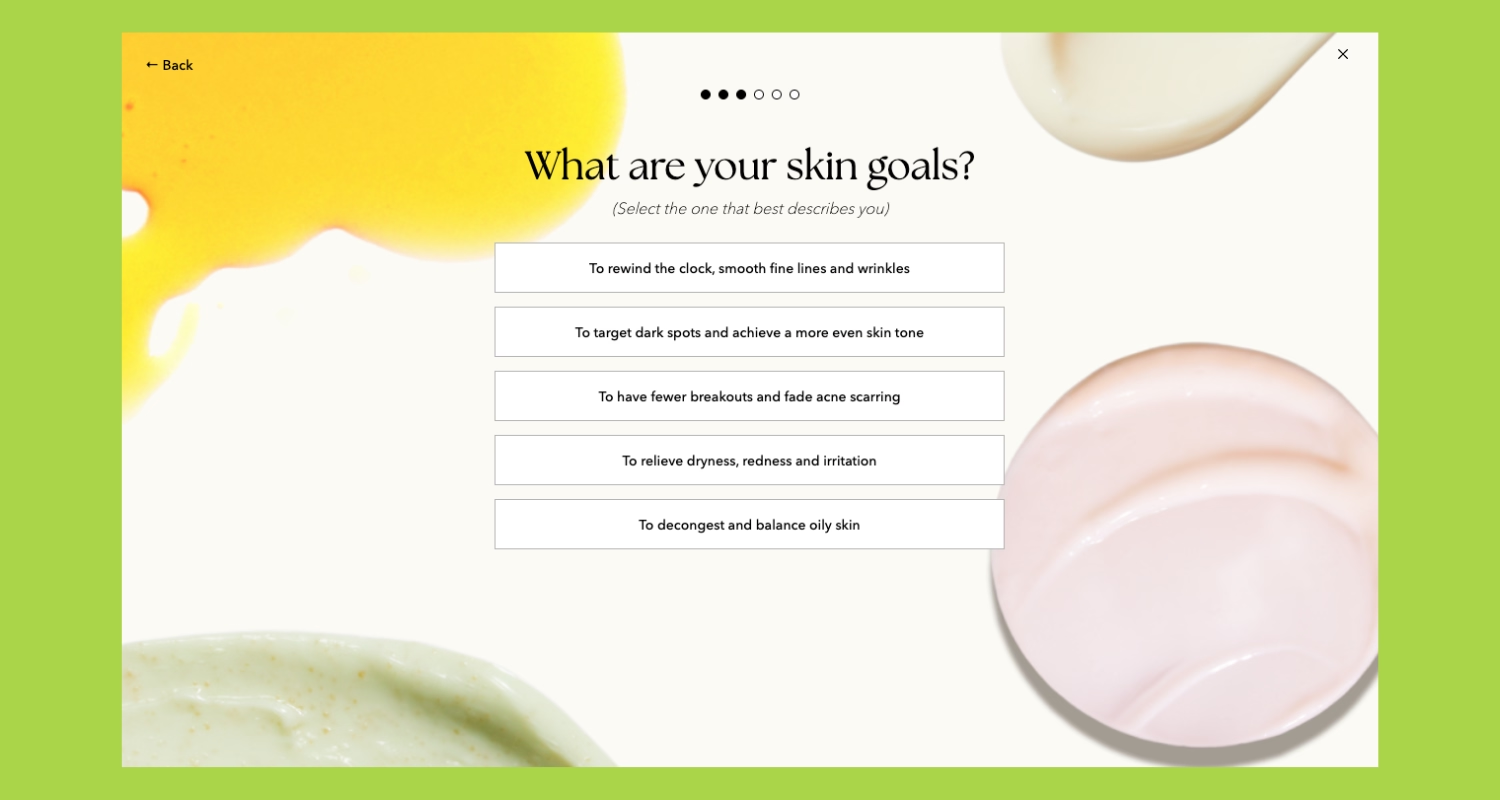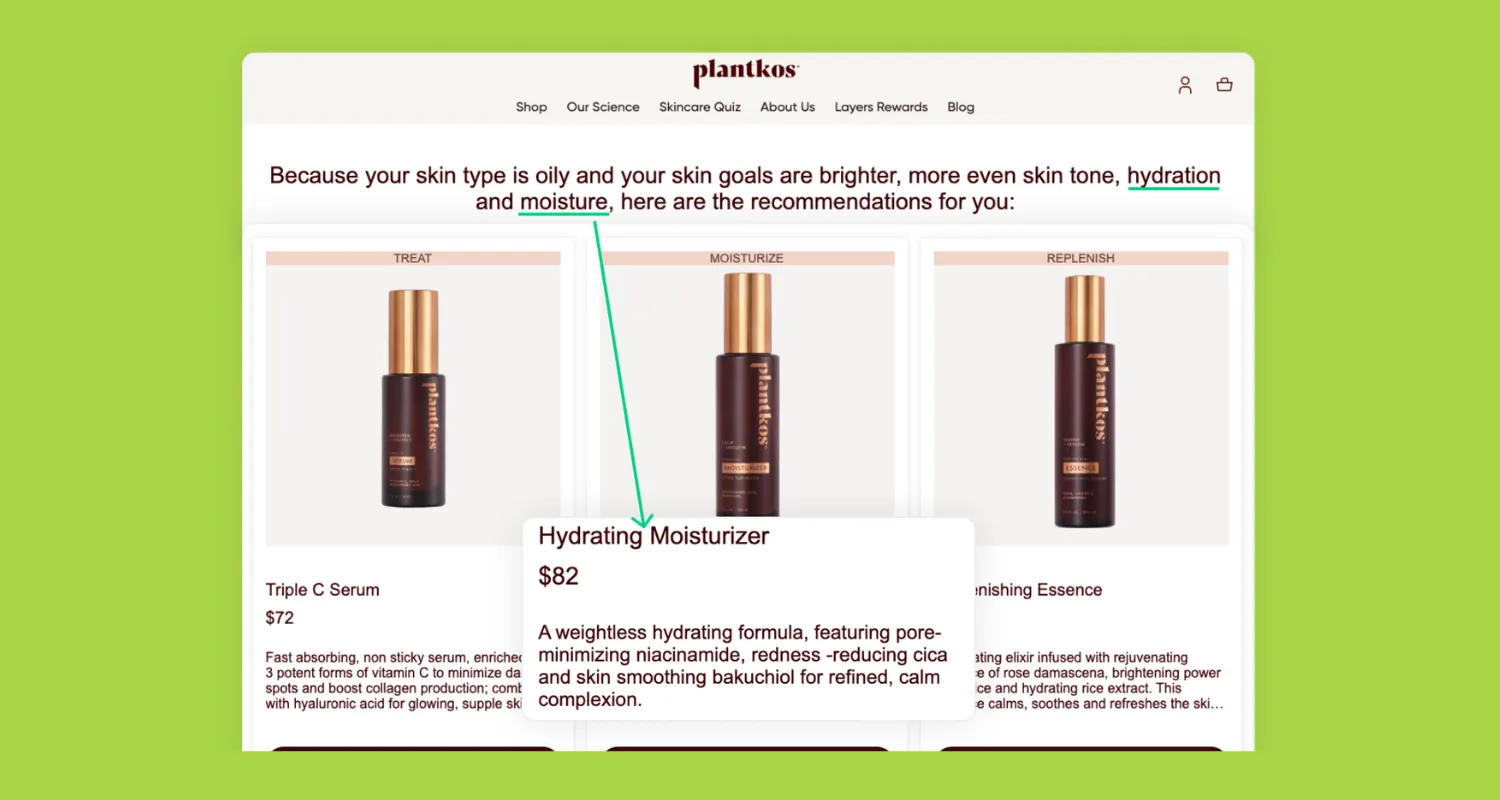July 31, 2025
Learn the essentials for creating a high-converting product quiz that captures zero-party data and keeps shoppers engaged.


Steal High-Converting Ideas From Leading DTC Brands
Browse 50+ real examples of personalized marketing funnels you can replicate today.
You know the feeling of walking into a store and having a salesperson ask, “What are you shopping for today?” A knowledgeable sales associate might then ask questions to guide you to the right product, creating a more satisfying experience. It’s a standard question in stores, so why aren’t more brands asking it online?
There's a simple way to do that: guided selling with product quizzes. With well-crafted questions, a quiz can act as an intelligent, interactive guide, helping visitors find the perfect product while allowing your brand to gather actionable insights to bridge the gap between anonymous browsing and meaningful customer profiles.
But how you set up your quiz can make all the difference.Follow these five steps to craft quizzes that feel personal, drive conversions, and power your entire marketing stack.
Launch Your First Quiz with Digioh
Start with a clear goal for your quiz: What do you need to know to improve your recommendations, messaging, or offers? What do you want to achieve with the data you’re collecting?
Whether your goal is to improve product recommendations, personalize email follow-ups, or drive loyalty, defining your purpose will guide every decision you make about the quiz.
When your quiz’s “why” is crystal clear, every question has a purpose and every answer becomes an opportunity.

Each quiz question should serve a specific purpose and align closely with the considerations your shoppers have during their buying journey. Here are question types that help you gather meaningful data while keeping the experience engaging:
These questions help you understand day-to-day habits. For example, “What’s your primary fitness goal?” helps Pvolve deliver tailored workout bundles and informs cross-sell opportunities.

Why it works: This not only provides insight into the shopper’s needs but also sets the stage for personalized product recommendations.
Tip: Use visuals, like icons or images, to illustrate each option and boost engagement.
To uncover specific motivations, ask about what matters most in their product selection. For example, “What are your skin goals?” uncovers motivators like anti-aging or hydration, guiding RANAVAT’s personalized picks.

Why it works: Focuses on emotional drivers, giving you direct insight into what challenges they’re trying to solve for so you can recommend products that directly address their concerns (and also help you identify potential new product lines).
Tip: Include an “Other” option with a free-text field to capture nuances you might miss.
Questions around personal style or preferences can help you segment users into categories. Asking “How do you want your bottoms to fit?” helps drive Andie Swim’s swimsuit style quiz (which has driven a 296% conversion lift for the brand).

Why it works: Asks about personal aesthetic preferences to recommend specific SKUs that align with their tastes.
Tip: Pepper in indirect questions (e.g., favorite weekend activity, preferred coffee blend) to infer sensitive details like age or lifestyle without sounding intrusive.

Rather than aiming for a fixed number of questions, consider the shopper journey and the type of product you offer. For many brands, a short quiz works well, but high-consideration products might benefit from longer quizzes to build shopper confidence.
Here are a few tips for structuring an effective quiz:
By combining conditional logic and progressive profiling, you respect your customer’s time, boost completion rates, and gather richer data.
Tip: Avoid “blank page syndrome” and use AI to build your quiz foundation
If you’re unsure where to start, AI tools like ChatGPT and Perplexity can help you brainstorm question ideas and map out branching paths. If you use Digioh, take advantage of our AI Headline Generator to help spin up on-brand copy in seconds.
A quiz should feel like a valuable exchange, not just a form to fill out. From the start, let shoppers know they’ll receive personalized recommendations based on their answers, making the process feel purposeful.
Here are a few tips to make sure your quiz experience feels rewarding:
Lead with a promise: “Answer 5 quick questions to discover your perfect match.” Use a succinct headline and subheader to reinforce value.
Make sure the quiz is visually engaging by adding elements like icons or images for answer choices, and, if it suits your brand, incorporate playful language that matches your tone.

Add a progress bar as a visual cue to reassure users they’re on track. For example, as quiz takers move through each step of Farm Hounds’ quiz, a cartoon pup makes its way toward a gift box. It’s a small creative detail that reflects the brand’s playful tone and keeps the experience light.
Offer a discount code or free shipping after quiz completion. A small, instant reward increases perceived value and boosts conversions.
Once the quiz taker gets to the results page, buttons like “Add All to Cart” make it easy to act on insights immediately. Include dynamic copy that references a user’s selected preferences to personalize the CTA.

For example, Plantko’s quiz results page opens with a personalized summary of the shopper’s skin type and goals, followed by recommended products with concise, benefit-led descriptions. It’s a simple but effective way to make recommendations feel more relevant and aligned to the shopper’s needs.
When the quiz feels rewarding and engaging instead of transactional, shoppers are more likely to complete it and enjoy the experience—and come back for future quizzes.
Gathering data is just step one. Once your quiz is live, it’s essential to have a system for organizing and storing the data effectively. Here’s how to turn it into results:
By setting up a structured data system from the start, you’ll be ready to maximize the potential of this zero-party data over time and turn your quizzes into a powerhouse for growth.
Product quizzes are more than just a fun interactive element. They’re a strategic tool for capturing rich zero-party data that fuels personalized experiences, drives higher conversions, and deepens customer loyalty.
By defining clear goals, crafting thoughtful questions, optimizing flow with conditional logic, creating a rewarding user experience, and rigorously activating and measuring your data, you’ll transform quizzes into your pathway to valuable insights and happier customers.
Ready to see how quizzes can elevate your brand? Launch Your First Quiz with Digioh

Zero-party data is information customers intentionally provide. Product quizzes ask engaging questions that reveal preferences and intent, ensuring accuracy and consent. Learn more about Digioh’s Zero-Party Data features.
First-party data tracks behavior (purchases, clicks); zero-party data uncovers motivations, preferences, and needs that aren’t observable in clicks alone. Explore the difference in our Zero-Party vs. First-Party Data deep dive.
A product quiz asks shoppers to share their preferences and needs directly, helping you collect zero-party data that you map to named fields and sync into your marketing stack . You can then use those responses to build hyper-targeted segments, trigger personalized email/SMS flows, and dynamically tailor onsite and paid-ad experiences for higher relevance and ROI.
The right quiz length depends on your product and audience, but aim for about 5–7 questions (no more than 8) so people don’t quit early. Use conditional logic to only show extra questions when they apply, and if you go past six questions, let users know it’ll take under three minutes so they stick with it.
On average, Digioh customers who add a product quiz see about three times more conversions. For example, Lull’s quiz drove a 144% lift in sales, and Andie Swim’s quiz boosted conversions by 296%. Quizzes guide shoppers to the right products and give you the info you need to send personalized follow-up offers that sell more.
Map each quiz response to a customer profile field, then use those attributes to fuel targeted email and SMS automations. Get step-by-step setup in our Digioh + Klaviyo Integration Guide.
Zero consumption based pricing with zero limits allows your brand to deploy Digioh across your entire marketing funnel.
book a demo
